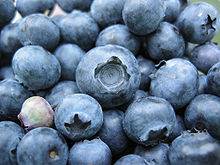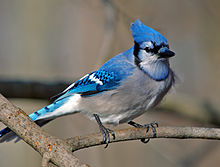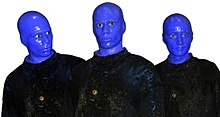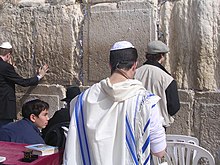Blue
| This article is written in American English, which has its own spelling conventions (color, defense, traveled) and some terms that are used in it may be different or absent from other varieties of English. According to the relevant style guide, this should not be changed without broad consensus. |
| Blue | |
|---|---|
| Wavelength | 440–490 nm |
| Common connotations | |
| ice, water, sky, sadness, winter, royalty, boys, cold, calm, conservatism (universally), liberalism (US), and capitalism | |
| Hex triplet | #0000FF |
| sRGBB (r, g, b) | (0, 0, 255) |
| HSV (h, s, v) | (240°, 100%, 100%) |
| CIELChuv (L, C, h) | (32, 131, 266°) |
| Source | HTML/CSS[1] |
| B: Normalized to [0–255] (byte) | |
Blue is a color, the perception of which is evoked by light having a spectrum dominated by energy with a wavelength of roughly 440–490 nm. It is considered one of the additive primary colors. On the HSV Color Wheel, the complement of blue is yellow; that is, a color corresponding to an equal mixture of red and green light. On a color wheel based on traditional color theory (RYB), the complementary color to blue is considered to be orange (based on the Munsell color wheel).[2] The English language commonly uses "blue" to refer to any color from navy blue to cyan. The word itself is derived from the Old French word bleu.
Etymology and definitions

The modern English word blue comes from the Middle English, bleu or blwe, which came from an Old French word bleu of Germanic origin (Frankish or possibly Old High German blao, "shining"). Bleu replaced Old English blaw. The root of these variations was the Proto-Germanic blæwaz, which was also the root of the Old Norse word bla and the modern Icelandic blár, and the Scandinavian word blå, but it can refer to other non blue colors. A Scots and Scottish English word for "blue-grey" is blae, from the Middle English bla ("dark blue," from the Old English blæd). Ancient Greek lacked a word for blue and Homer called the color of the sea "wine dark", except that the word kyanos (cyan) was used for dark blue enamel.
As a curiosity, blue is thought to be cognate with blond, blank and black through the Germanic word. Through a Proto-Indo-European root, it is also linked with Latin flavus ("yellow"; see flavescent and flavine), with Greek phalos (white), French blanc (white, blank) (borrowed from Old Frankish), and with Russian белый, belyi ("white," see beluga), and Welsh blawr (grey) all of which derive (according to the American Heritage Dictionary) from the Proto-Indo-European root *bhel- meaning "to shine, flash or burn", (more specifically the word bhle-was, which meant light colored, blue, blond, or yellow), whence came the names of various bright colors, and that of color black from a derivation meaning "burnt" (other words derived from the root *bhel- include bleach, bleak, blind, blink, blank, blush, blaze, flame, fulminate, flagrant and phlegm).
In the English language, blue may refer to the feeling of sadness. "He was feeling blue". This is because blue was related to rain, or storms, and in Greek mythology, the god Zeus would make rain when he was sad (crying), and a storm when he was angry. Kyanos was a name used in Ancient Greek to refer to dark blue tile (in English it means blue-green or cyan).[3] The phrase "feeling blue" is linked also to a custom among many old deepwater sailing ships. If the ship lost the captain or any of the officers during its voyage, she would fly blue flags and have a blue band painted along her entire hull when returning to home port.[4]
Many languages do not have separate terms for blue and or green, instead using a cover term for both (when the issue is discussed in linguistics, this cover term is sometimes called grue in English).
In science

Pigments
Traditionally, blue has been considered a primary color in painting, with the secondary color orange as its complement.
Blue pigments include azurite (Cu3(CO3)2(OH)2), ultramarine (Na8-10Al6Si6O24S2-4), cerulean blue (primarily cobalt (II) stanate: Co2SnO4), cobalt blue (cobalt(II) aluminate: CoAl2O4), and Prussian blue (milori blue: primarily Fe7(CN)18).
Scientific natural standards for blue
- Emission spectrum of Cu2+
- Electronic spectrum of aqua-ions Cu(H2O)52+
Animals

- When an animal's coat is described as "blue", it usually refers to a shade of grey that takes on a bluish tint, a diluted variant of a pure black coat.[citation needed] This designation is used for a variety of animals, including dog coats, some rat coats, cat coats, some chicken breeds, and some horse coat colors.
In human culture
Symbolic language
- In the English language, blue often represents the human emotion of sadness, e.g. "He was feeling blue". In German, on the other hand, to be "blue" (blau sein) is to be drunk. This derives from the ancient use of urine (which is produced copiously by the human body after drinking alcohol) in dyeing cloth blue with woad or indigo.[5]
Music

- The blues is a style of music originated by African Americans.
- The Blue Man Group is a performance arts and experimental rock band whose members are painted blue.
- In 1999 Eiffel 65 released the song "Blue (Da Ba Dee)," a hugely popular Eurodance song which peaked at #2 on the Billboard Hot 100 in the United States, and reached #1 in 17 countries.[citation needed]
- Blue is the name of the original Scottish rock group
- Blue is also the name of an English pop boy band.
National colors


- Azzurro a light blue, is the national color of Italy (from the livery color of the former reigning family, the House of Savoy)[citation needed].
- Blue is the national sports color for India, as it denotes secularism.
- Blue is the national color used on flags of several countries surrounded by seas or oceans such as Australia and Europe, though not necessarily with this interpretation in mind.[citation needed]

- Blue and white are the national colors of Argentina, El Salvador, Finland, Greece, Guatemala, Honduras, Israel, Micronesia, Nicaragua, and Somalia as well as of the United Nations Organization using a light shade of blue symbolizing peace.
- Blue and yellow are the national colors of Barbados, Kazakhstan, Palau, Sweden, and Ukraine, and along with green, of Brazil, and along with red, of Chad, Colombia, Ecuador, Moldova, Romania, and Venezuela.
- Blue, white and yellow are the national colors of Bosnia and Herzegovina, Kosovo and Uruguay.
- Blue and red are the national colors of Haiti and Liechtenstein, and along with white (where it composed the French tricolor whose simple design or colors were taken by other countries), of Australia, Cambodia, Costa Rica, Chile, Croatia, Cuba, the Czech Republic, the Dominican Republic, France, Iceland, North Korea, Laos, Liberia, Luxembourg, Myanmar, Nepal, the Netherlands, New Zealand, Norway, Panama, Paraguay, Russia, Samoa, Serbia, Slovakia, Slovenia, Thailand, the United Kingdom, and the United States.
- Blue, white and black are the national colors of Estonia.[6]
Mysticism
- In the metaphysics of the "New Age Prophetess", Alice Bailey, in her system called the Seven Rays which classifies humans into seven different metaphysical psychological types, the "first ray" of "will-power" is represented by the color blue. People who have this metaphysical psychological type are said to be "on the Blue Ray".[7]
- In Hinduism, Blue is used to symbolically represent the fifth, throat chakra (Vishuddha).[8]
- Psychics who claim to be able to observe the aura with their third eye report that someone with a blue aura is a person who is oriented toward spirituality.[9] People with blue auras are said to be interested in social service work and to be in occupations such as social worker, counsellor, teacher, writer, and psychologist.[10]
Politics
- Blue has been associated with a variety of political positions, often differentiated from communist red or anarchist black. During the revolt in the Vendée against the French revolution, blues stood for the revolutionary forces, and white for the counter-revolutionaries. Later movements like the Breton blues used the color to signify allegiance to the ideals of the revolution.
- In the United Kingdom and Canada blue is the color of the respective Conservative Parties. In the United States, however, it has become fashionable since the 2000 Presidential Election to refer to the Democratic Party as "blue" and the Republican Party as "red", particularly as in reference to "red states and blue states".
- The Blue Dog Democrats are a group of conservative Democrats in the United States House of Representatives.

Religion
- Blue in Hinduism: Many of the gods are depicted as having blue-colored skin, particularly those associated with Vishnu, who is said to be the Preserver of the world and thus intimately connected to water. Krishna and Ram, Vishnu's avatars, are usually blue. Shiva, the Destroyer, is also depicted in light blue tones and is called neela kantha, or blue-throated, for having swallowed poison in an attempt to turn the tide of a battle between the gods and demons in the gods' favour.
- Blue in Judaism: In the Torah,[11] the Israelites were commanded to put fringes, tzitzit, on the corners of their garments, and to weave within these fringes a "twisted thread of blue (tekhelet)".[12] In ancient days, this blue thread was made from a dye extracted from a Mediterranean snail called the hilazon. Maimonides claimed that this blue was the color of "the clear noonday sky"; Rashi, the color of the evening sky.[13] According to several rabbinic sages, blue is the color of God's Glory.[14] Staring at this color aids in mediation, bringing us a glimpse of the "pavement of sapphire, like the very sky for purity", which is a likeness of the Throne of God.[15] (The Hebrew word for glory.) Many items in the Mishkan, the portable sanctuary in the wilderness, such as the menorah, many of the vessels, and the Ark of the Covenant, were covered with blue cloth when transported from place to place.[16]
- Blue in Islam: In verse 20:102 of the Qur’an, the word زرق zurq (plural of azraq 'blue') is used metaphorically for evildoers whose eyes are glazed with fear, as if the sclera is filmed over with a bluish tint.
- Blue in Christianity: This color in some traditions is sometimes associated with the clothing of heavenly figures, most commonly (especially in the Catholic tradition) that of Saint Mary. Ironically, it also has connections with the deadly sin of lust.
Symbolism
- In Thailand, blue is associated with Friday on the Thai solar calendar. Anyone may wear blue on Fridays and anyone born on a Friday may adopt blue as their color. The Thai language, however, is one that has had trouble distinguishing blue from green. The default word for Blue was recently สีน้ำเงิน literally, the color of silver, a poetical reference to the silvery sheen of the deep blue sea. It now means Navy Blue, and the default word is now สีฟ้า literally, the color of the sky.[17]
- In the early 1960s, the United States Air Force ran a television commercial with this jingle:
Variations of blue
Dark blue
| Dark blue | |
|---|---|
| Hex triplet | #00008B |
| sRGBB (r, g, b) | (0, 0, 139) |
| HSV (h, s, v) | (240°, 100%, 55%) |
| CIELChuv (L, C, h) | (15, 60, 266°) |
| Source | X11 |
| B: Normalized to [0–255] (byte) | |
Dark blue is a shade of blue. The name comes from the word "Dark" (which originated from Old English dark, derk, deork; Anglo-Saxon dearc, and Gaelic and Irish dorch, dorcha) and "Blue" (taken from French and originated from the Indo-European root bhlewos).
Medium blue
| Medium blue | |
|---|---|
| Hex triplet | #0000CD |
| sRGBB (r, g, b) | (0, 0, 205) |
| HSV (h, s, v) | (240°, 100%, 80%) |
| CIELChuv (L, C, h) | (25, 101, 266°) |
| Source | X11 |
| B: Normalized to [0–255] (byte) | |
Displayed at right is the color medium blue.
Light blue
| Light Blue | |
|---|---|
| Hex triplet | #ADD8E6 |
| sRGBB (r, g, b) | (173, 216, 230) |
| HSV (h, s, v) | (195°, 25%, 90%) |
| CIELChuv (L, C, h) | (84, 28, 216°) |
| Source | X11 |
| B: Normalized to [0–255] (byte) | |
The web color light blue is displayed in the color box at right. Also could be known as sky blue, baby blue, or angel blue. The first recorded use of "light blue" as a color term in English is in the year 1915.[18]
Pigment blue
| Pigment Blue | |
|---|---|
| Hex triplet | #333399 |
| sRGBB (r, g, b) | (51, 51, 153) |
| HSV (h, s, v) | (240°, 67%, 60%) |
| CIELChuv (L, C, h) | (28, 73, 266°) |
| Source | CMYK |
| B: Normalized to [0–255] (byte) | |
At right is the color pigment blue. This is the color that is achieved by mixing an equal amount of process cyan (printer's cyan) and process magenta (printer's magenta).
Variations of blue in culture
Fashion
- Dark clothing for males such as dark blue business suits have become much more popular since the mid-1990s,[citation needed] as opposed to the pastel colored business suits worn in the 1970s by major leaders in such institutions as the United States Congress (the vast difference in the clothing worn in the 1970s as opposed to the 2000s can be readily seen by looking at a videotape of the Watergate hearings).

- In some parts of the world, police wear dark blue or, sometimes, medium blue uniforms. However, the New Age philosopher Alan Watts suggested in the 1960s that police ought to wear baby blue uniforms.[citation needed]
Human sexuality
- In the bandana code of the gay leather subculture, wearing a medium blue bandana means one is into the fetish of having sex with someone who is wearing a police uniform.[19]
- In Russian, the word for light blue, голубой, can be used to mean 'homosexual'.[20]
Sociology
- Dark blue represents knowledge, power, integrity, and seriousness. In Western civilization, those in the upper classes in high places of political or economic power often wear dark blue suits. Ordinary members of the working class (especially those who work in the computer industry) often refer derisively to these management functionaries as the suits.[21] This terminology is also used in the television industry--the network executives are often referred to by the creative people (actors, directors, and screenwriters) as the suits.[22]
- In historical atlases published in Germany, light blue is traditionally used as a color to represent Germany, as opposed to pink for England, purple for France, and light green for Russia.[23]
See also
- Blue flag
- Blue movie
- Blue ribbon
- Blue Screen of Death
- Distinguishing "blue" from "green" in language
- Engineer's blue
- Lapis lazuli, a blue stone
- List of colors
- Non-photo blue
- Three Colors: Blue, a film
- St. Patrick's Blue
- Turquoise
References
- ^ "W3C TR CSS3 Color Module, HTML4 color keywords". W3.org. Retrieved 2009-04-14.
- ^ "Glossary Term: Color wheel". Sanford-artedventures.com. Retrieved 2009-04-14.
- ^ Merriam-Webster's Ninth New Collegiate Dictionary Springfield, Mass.:1984--Merriam-Webster Page 319
- ^ "US Navy - origins of Navy Terminology" [1]
- ^ Heller, Eva. Wie Farben wirken: Farbpsychologie, Farbsymbolik, kreative Farbgestaltung. Berlin: Rowohlt, 2004.
- ^ "Estonia in brief: National Symbols" at Estonica website (www.estonica.org)[2]
- ^ Bailey, Alice A. (1995). The Seven Rays of Life. New York: Lucis Publishing Company. ISBN 0853301425.
- ^ Stevens, Samantha. The Seven Rays: a Universal Guide to the Archangels. City: Insomniac Press, 2004. ISBN 1894663497 pg. 24
- ^ Swami Panchadasi The Human Aura: Astral Colors and Thought Forms Des Plaines, Illinois, USA:1912--Yogi Publications Society Page 36
- ^ Oslie, Pamalie Life Colors: What the Colors in Your Aura Reveal Novato, California:2000--New World Library Blue Auras: Pages 117-130
- ^ Numbers 15:38.
- ^ http://www.tekhelet.com The Ptil Tekhelet Organization
- ^ Mishneh Torah, Tzitzit 2:1; Commentary on Numbers 15:38.
- ^ Numbers Rabbah 14:3; Hullin 89a.
- ^ Exodus 24:10; Ezekiel 1:26; Hullin 89a.
- ^ Numbers 4:6-12.
- ^ Glenn Slayden. "Bot generated title ->". thai-language.com<!. Retrieved 2009-04-14.
- ^ Maerz and Paul A Dictionary of Color New York:1930 McGraw-Hill Page 190
- ^ Card showing list of bandana colors and their meanings, available at Image Leather, 2199 Market St., San Francisco, CA 94114
- ^ "Gay.ru". English.gay.ru. Retrieved 2009-04-14.
- ^ The Cuckoo's Egg: Tracking a Spy Through the Maze of Computer Espionage, Clifford Stoll, 1989, ISBN 0-7434-1146-3
- ^ Shatner, William (with Chris Kreski) Star Trek Memories New York:1993 Harper Collins
- ^ See the Grosshistoricher Weltatlas, 1965 edition (Other German historical atlases use these same colors.)

